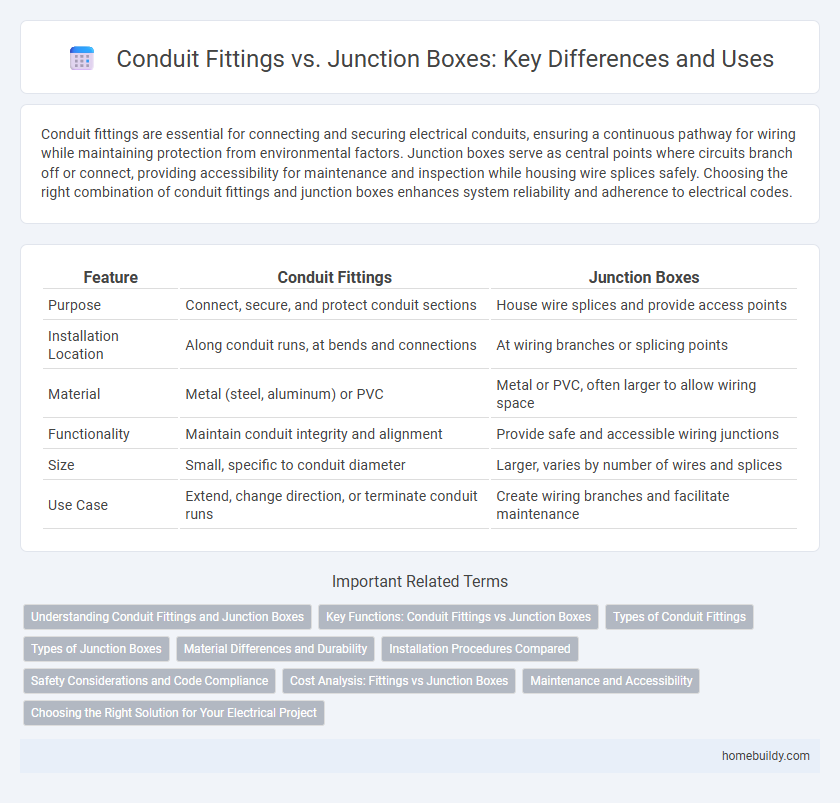Conduit fittings are essential for connecting and securing electrical conduits, ensuring a continuous pathway for wiring while maintaining protection from environmental factors. Junction boxes serve as central points where circuits branch off or connect, providing accessibility for maintenance and inspection while housing wire splices safely. Choosing the right combination of conduit fittings and junction boxes enhances system reliability and adherence to electrical codes.
Table of Comparison
| Feature | Conduit Fittings | Junction Boxes |
|---|---|---|
| Purpose | Connect, secure, and protect conduit sections | House wire splices and provide access points |
| Installation Location | Along conduit runs, at bends and connections | At wiring branches or splicing points |
| Material | Metal (steel, aluminum) or PVC | Metal or PVC, often larger to allow wiring space |
| Functionality | Maintain conduit integrity and alignment | Provide safe and accessible wiring junctions |
| Size | Small, specific to conduit diameter | Larger, varies by number of wires and splices |
| Use Case | Extend, change direction, or terminate conduit runs | Create wiring branches and facilitate maintenance |
Understanding Conduit Fittings and Junction Boxes
Conduit fittings are essential components that connect and secure electrical conduit sections, ensuring a continuous path for wiring while protecting cables from damage and environmental factors. Junction boxes serve as accessible enclosures where electrical connections are housed, offering a safe space for wire splicing, branching, and maintenance. Both conduit fittings and junction boxes play crucial roles in maintaining the integrity, safety, and functionality of electrical conduit systems.
Key Functions: Conduit Fittings vs Junction Boxes
Conduit fittings primarily provide secure connections, transitions, and bends in electrical conduit runs to protect and route wiring efficiently. Junction boxes serve as centralized enclosure points where multiple conduits meet, allowing safe access for wire splicing, inspection, and maintenance. Both components are essential for ensuring electrical system integrity, with fittings focusing on conduit continuity and junction boxes facilitating wiring organization and safety compliance.
Types of Conduit Fittings
Conduit fittings include couplings, connectors, adapters, and reducers, each designed to secure conduit sections and connect to electrical boxes or devices. Types such as set-screw fittings, compression fittings, and threaded fittings provide versatility for using metal, PVC, or flexible conduits. Proper selection of conduit fittings ensures a secure, continuous electrical path while protecting wiring from environmental damage and mechanical stress.
Types of Junction Boxes
Junction boxes come in various types including square, rectangular, octagonal, and round shapes, each designed to accommodate different wiring configurations and space requirements for electrical conduit systems. These boxes provide secure enclosures for splicing wires and connecting conduit fittings, ensuring safety and protection against electrical hazards. Unlike conduit fittings, which connect and route conduit pipes, junction boxes serve as central points for wire connections and branching within electrical installations.
Material Differences and Durability
Conduit fittings are typically made from materials like PVC, steel, or aluminum, offering corrosion resistance and flexibility for various electrical installations. Junction boxes are often constructed from steel or plastic, designed to provide sturdy protection for electrical connections while preventing moisture and dust ingress. The durability of conduit fittings largely depends on the material's resistance to environmental factors, whereas junction boxes prioritize robust structural integrity and environmental sealing for long-term reliability.
Installation Procedures Compared
Conduit fittings require precise threading and secure tightening to ensure proper alignment and electrical continuity, often involving specific tools for cutting, threading, and sealing. Junction boxes installation necessitates mounting the box securely while managing multiple conduit entries, providing easier access for wire splicing and maintenance. Both procedures demand adherence to electrical codes and standards, but conduit fittings focus more on mechanical connections, whereas junction boxes emphasize access and wiring organization.
Safety Considerations and Code Compliance
Conduit fittings and junction boxes both play essential roles in electrical conduit systems, with safety considerations focusing on secure connections and protection against electrical faults. Conduit fittings ensure proper alignment and grounding of conduit runs, minimizing risks of loose connections or exposed wiring, while junction boxes provide accessible points for cable splicing and circuit modifications, complying with NEC (National Electrical Code) requirements for enclosure and protection. Adhering to code compliance guarantees that conduit fittings and junction boxes maintain system integrity, prevent electrical hazards, and meet inspection standards.
Cost Analysis: Fittings vs Junction Boxes
Conduit fittings generally offer a lower upfront cost compared to junction boxes, making them a budget-friendly option for simple electrical connections and directional changes. Junction boxes, while more expensive initially, provide enhanced protection, easier access for maintenance, and better organization for complex wiring systems, which can reduce long-term labor costs. Choosing between conduit fittings and junction boxes depends on project complexity, with fittings minimizing material costs and junction boxes offering cost-effective durability and safety benefits over time.
Maintenance and Accessibility
Conduit fittings provide streamlined access points for wiring changes and repairs, allowing for quick maintenance without extensive disassembly. Junction boxes offer a central location for wire connections and serve as crucial access hubs, simplifying troubleshooting and upgrades. Both components enhance system accessibility but serve distinct roles in electrical conduit maintenance efficiency.
Choosing the Right Solution for Your Electrical Project
Selecting between conduit fittings and junction boxes depends on the specific requirements of your electrical project, such as space constraints, accessibility, and wiring complexity. Conduit fittings provide secure, flexible connections for continuous runs of conduit, ideal for maintaining a streamlined conduit system. Junction boxes offer convenient access points for wire splicing and branching, essential for complex circuits and future maintenance.
Conduit fittings vs Junction boxes Infographic

 homebuildy.com
homebuildy.com